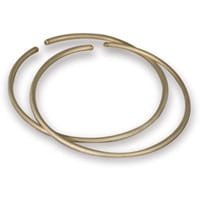ISO-F HV Retaining Rings: Lightweight Aluminum Coupling for ISO-K to ISO-F High-Vacuum Flange Transitions
ISO-F HV Retaining Rings are specialized components used in high-vacuum (HV) systems to securely mate ISO-K flanges to ISO-F flanges of the same nominal size. Designed as a functional bridge between the two standard ISO flange styles, these retaining rings ensure proper alignment and mechanical fastening of hybrid flange connections in systems where clamp-fastened and bolt-fastened components are used together.
TFM manufactures these ISO-F HV Retaining Rings from lightweight aluminum, providing strength and corrosion resistance while minimizing the overall mass of the vacuum assembly. Their low weight is particularly advantageous in vertically mounted equipment, mobile platforms, or applications where component handling ease and installation speed are priorities.
Unlike full bolt rings, ISO-F HV Retaining Rings serve as replacement or supplementary connectors and are specifically designed to support mating between ISO-K and ISO-F styles. These rings do not include the bolt ring itself, making them an ideal maintenance or system expansion part when only the interface ring is needed and existing hardware is reused.
Key Features of ISO-F HV Retaining Rings:
ISO-K to ISO-F Compatibility
Designed to securely join ISO-K clamp-style flanges with ISO-F bolt-style flanges of equal size, maintaining flange alignment and sealing pressure.Aluminum Construction
Offers excellent corrosion resistance and mechanical rigidity while keeping weight low—ideal for general-purpose HV applications.Vacuum Integrity Support
Ensures proper compression of the o-ring in conjunction with standard ISO centering rings, supporting vacuum levels down to 10⁻⁸ Torr when assembled correctly.Replacement Friendly
Intended for use as replacement parts, these retaining rings do not include bolt rings or fastening hardware, making them a cost-effective solution for field maintenance or equipment upgrades.
These ISO-F HV Retaining Rings are compatible with all standard ISO flange sizes, including ISO63, ISO100, ISO160, ISO200, ISO250, ISO320, and ISO400. Each ring is machined to precision tolerances to ensure accurate mating and consistent flange performance. For specialized configurations, TFM can provide custom retaining ring designs with features such as vent holes, surface treatments, or engraved part numbers for traceability.
In summary, ISO-F HV Retaining Rings are a practical and efficient solution for mating ISO-K and ISO-F flanges in high-vacuum systems. Their lightweight aluminum construction, ISO compatibility, and role-specific design make them an essential utility for vacuum system maintenance, assembly, and hybrid flange integration.
Ordering Table
| Flange OD | Reference | Part Number |
| ISO63 | Retaining Ring | QF63-RR |
| ISO80 | Retaining Ring | QF80-RR |
| ISO100 | Retaining Ring | QF100-RR |
| ISO160 | Retaining Ring | QF160-RR |
| ISO200 | Retaining Ring | QF200-RR |
| ISO250 | Retaining Ring | QF250-RR |
| ISO320 | Retaining Ring | QF320-RR |
| ISO400 | Retaining Ring | QF400-RR |
| ISO500 | Retaining Ring | QF500-RR |





Reviews
There are no reviews yet.